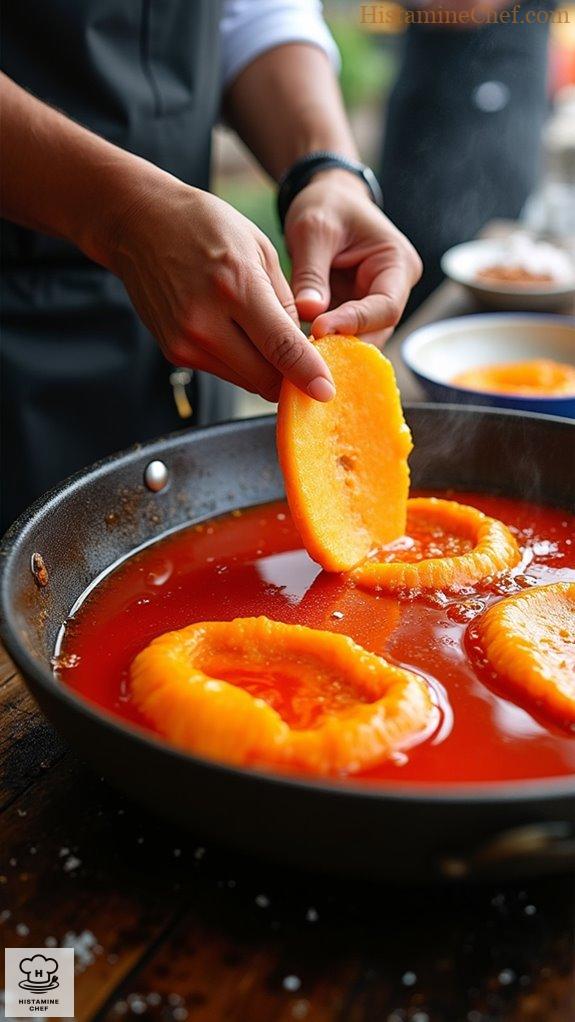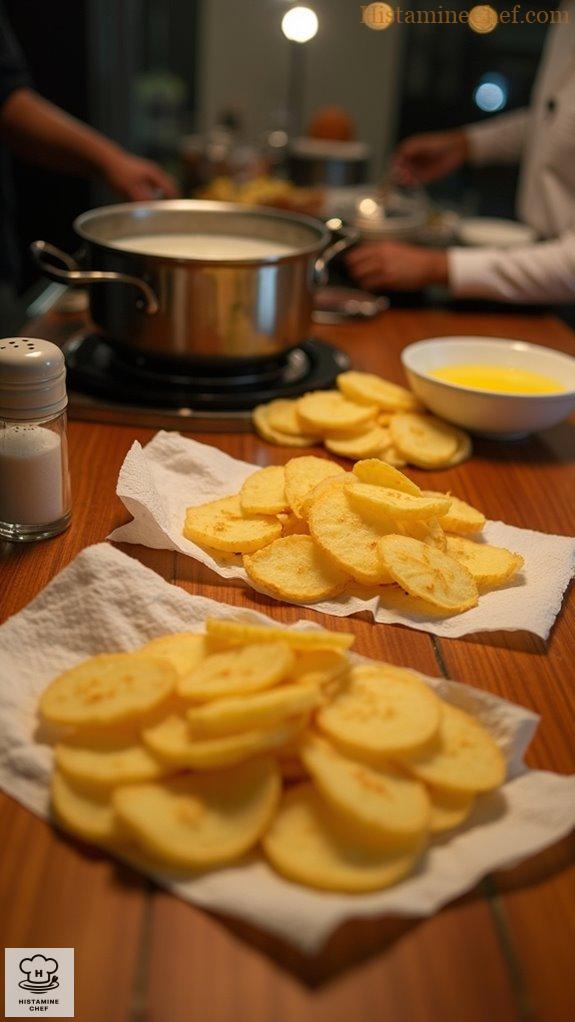Want to whip up some Nigerian chips that are lower in histamines? It’s a flavorful journey! Grab fresh, unripe plantains, slice them thin, and fry in extra virgin olive oil or coconut oil until golden brown. Don’t go wild with spices; just a pinch of salt will do. Trust me, these crispy bites deliver on taste without the aftermath! Curious about more delicious alternatives and tips? There’s plenty more to explore in this culinary adventure!
Vibrant Street Food Scene

Nigerian street food culture is a vibrant tapestry woven from a rich history of culinary traditions and communal gatherings, showcasing the diverse flavors and ingredients that define the country’s culinary environment. Originating from ancient practices where food was prepared and sold by local vendors, this culture has evolved throughout history, influenced by Nigeria’s multicultural demographics and socio-economic changes. Street food vendors today offer a variety of delicious options, from spicy grilled meats and crispy fried snacks to delectable rice dishes and pastries, each reflecting the local community’s flavors. The use of fresh, locally sourced ingredients guarantees that these meals aren’t only authentic but also tied to the region’s agricultural practices. With the African Street Food Market valued at USD 11.8 Billion in 2024, this culinary phenomenon serves as an essential part of urban life, providing affordable, quick, and flavorful meals to city dwellers. As street food continues to thrive, it remains a vital element of Nigeria’s economy and social fabric, fostering cultural exchange and enhancing the tourism experience, with the preparation of items like Nigerian chips becoming synonymous with the country’s dynamic street food scene.
Deep-Fried in Palm Oil

Street vendors cook Nigerian chips by first selecting firm, fresh yam tubers and peeling them before cutting them into thick slices or finger-like strips.
The yam pieces are thoroughly rinsed under running water to remove excess starch, then lightly salted and patted dry to minimize oil splatter.
In a deep pan or wok, red palm oil is heated until it just begins to smoke. Yam slices are gently added in batches, ensuring not to overcrowd the pan.
The heat is slightly reduced, allowing the yam to fry evenly until golden brown and crispy, typically taking about 5-7 minutes.
Adding small amounts of water during frying creates a tender interior while maintaining the crispy exterior.
Once done, the chips are drained and served hot, reminiscent of the traditional street food experience common in Nigeria.
Ingredients
- 2 large firm yam tubers
- 500 ml red palm oil
- 1 teaspoon salt
- Water (small amounts, as needed)
- Optional: spices (avoid high-histamine varieties)
Cooking Steps
- Select fresh, firm yam tubers.
- Peel and cut yam into thick slices.
- Rinse yam pieces under running water.
- Lightly salt the yam slices.
- Pat yam pieces dry with a cloth.
- Heat palm oil until it begins to smoke.
- Fry yam slices until golden brown.
- Drain and serve hot.
Fry With Minimal Spices

To prepare Nigerian chips at home, start by slicing fresh potatoes into thin strips and soaking them in cold water for about 30 minutes to remove excess starch.
Drain and pat dry the slices thoroughly to guarantee they fry crispy.
Heat coconut oil in a deep pot and fry the potato strips in batches, avoiding overcrowding, until golden brown and crispy—about 5-7 minutes.
Once fried, place them on paper towels to absorb excess oil.
For seasoning, use just a bit of table salt to keep it SIGHI-friendly, avoiding any restricted spices.
Enjoy them hot for the best texture and flavor.
- Slice fresh potatoes thinly
- Soak in cold water 30 minutes
- Drain and pat dry thoroughly
- Heat coconut oil for frying
- Fry batches until golden brown
- Drain on paper towels
- Season with table salt only
Low Histamine Variation of Plantain Chips

Histamine intolerance can greatly impact individuals’ ability to enjoy street food, which often contains high-histamine ingredients.
Common elements in street food, such as fermented sauces and pickled vegetables, can trigger adverse reactions in those sensitive to histamines.
Eating street food, like Nigerian chips, poses a risk for individuals with histamine intolerance due to the use of restricted ingredients. For instance, popular toppings or dips might contain high-histamine foods such as vinegar or spices listed on the SIGHI list, including mustard and soy sauce.
Furthermore, the possibility of cross-contamination with restricted foods in cooking environments can further complicate safe consumption for those with sensitivities.
Instructions for Low Histamine Plantain Chips:
- Use fresh, unripe plantains instead of overripe ones.
- Avoid any added spices from the restricted list when seasoning.
- Use extra virgin olive oil or coconut oil for frying.
- Cut plantains into thin slices for even frying.
- Heat oil in a pan to medium temperature before adding plantains.
- Fry plantain slices until golden brown and crispy, around 3-5 minutes.
- Remove chips from oil and drain on paper towels.
- Season lightly with salt; avoid any other condiments or dips.
- Serve warm; enjoy on their own or with fresh herbs.
- Store leftovers in a sealed container in a cool, dark place.
Video Summary
Nigerian chips, also known as chin chin, are a popular snack enjoyed across Nigeria, known for their crunchiness and sweetness. We’ll explore both the authentic street version and a lower histamine variation.
Street vendors start by gathering all the necessary ingredients: flour, sugar, and butter. They mix the flour and sugar in a large bowl. Next, they add butter, combining the mixture until it resembles crumbs.
Then they pour in milk, stirring until a dough forms. Once the dough is kneaded, vendors roll it out to about one centimeter thick. They use a sharp knife or pizza cutter to slice the dough into bite-sized pieces.
In deep frying pans, they heat oil until it’s bubbling. The bite-sized pieces are carefully added to the hot oil in batches. After a few minutes, they turn golden brown. Vendors scoop them out and let them cool on paper towels.
The crispy, sweet chips are ready to be enjoyed!
For the lower histamine version at home, we’ll make some key adjustments. Start with gluten-free flour instead of regular flour. Use coconut oil instead of butter for a low histamine option.
Substitute cow’s milk with almond milk to avoid histamine triggers. Do not use standard sugar; opt for agave syrup instead. When frying, use extra virgin olive oil instead of regular frying oil.
Make sure to monitor the temperature closely for the perfect crispness. The final meal is a golden treat that’s both crunchy and sweet, perfect for snacking.
Click the link in the description for the full recipe!
References
- https://www.futuredatastats.com/african-street-food-market
- http://mit.edu/~ecprice/Public/freq/googlelist.counts
- https://pure-oai.bham.ac.uk/ws/portalfiles/portal/217317954/Street_vended_foods_in_Nigeria_An_analysis_of_the_current_state_of_affairs_and_the_way_forward.pdf
- https://www.statista.com/outlook/cmo/food/confectionery-snacks/snack-food/nigeria
- https://www.statista.com/outlook/cmo/food/nigeria
- https://www.myactivekitchen.com/2015410-fried-yam-recipe-and-fried-sauce/


Leave a Reply